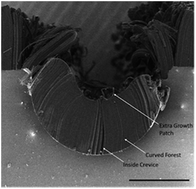Curvature-induced defects on carbon-infiltrated carbon nanotube forests
Abstract
A morphological study of the micro-scale defects induced by growing a carbon-infiltrated carbon nanotube (CICNT) forest on concave substrates was conducted. Two CICNT heights (roughly 60 μm and 400 μm) and 4 curvatures (1–4 mm ID) were studied in order to test the geometric limitations. Defects were categorized and quantified by scanning electron microscopy (SEM) of the tops and cross-sections. These deformities were categorized as increased roughness on the top surface, a corrugated (also called wavy or rippled) forest, a curved forest, an inside crevice where the forest separates, and increased forest density on the top surface. Roughness increased nearly 3-fold with the taller forest heights no matter the substrate curvature. Due to the geometric limitations of CICNT height and substrate curvature, all other microscale defects were significantly more present on samples with a small radius of curvature and a tall CICNT forest (p < 0.05). These buckling and warping types of defects were attributed to the increase in circumferential compression as the forest grows as well as the van der Waals interactions between the nanotubes. Because the fabrication process for CICNT involves growing a CNT forest and then infiltrating it with pyrolytic carbon, this work may be applicable to other CNT forests on concave substrates within these forest heights and substrate curvatures.



 Please wait while we load your content...
Please wait while we load your content...